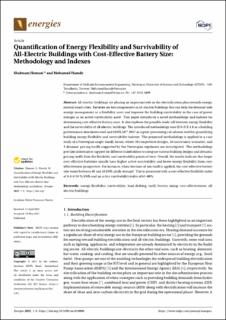| dc.contributor.author | Homaei, Shabnam | |
| dc.contributor.author | Hamdy, Mohamed | |
| dc.date.accessioned | 2022-03-04T08:21:11Z | |
| dc.date.available | 2022-03-04T08:21:11Z | |
| dc.date.created | 2021-05-13T15:17:09Z | |
| dc.date.issued | 2021 | |
| dc.identifier.citation | Energies. 2021, 14 (10), . | en_US |
| dc.identifier.issn | 1996-1073 | |
| dc.identifier.uri | https://hdl.handle.net/11250/2982983 | |
| dc.description.abstract | All-electric buildings are playing an important role in the electrification plan towards energy-neutral smart cities. Batteries are key components in all-electric buildings that can help the demand-side energy management as a flexibility asset and improve the building survivability in the case of power outages as an active survivability asset. This paper introduces a novel methodology and indexes for determining cost-effective battery sizes. It also explores the possible trade-off between energy flexibility and the survivability of all-electric buildings. The introduced methodology uses IDA-ICE 4.8 as a building performance simulation tool and MATLAB® 2017 as a post-processing calculation tool for quantifying building energy flexibility and survivability indexes. The proposed methodology is applied to a case study of a Norwegian single-family house, where 10 competitive designs, 16 uncertainty scenarios, and 3 dynamic pricing tariffs suggested by the Norwegian regulators are investigated. The methodology provides informative support for different stakeholders to compare various building designs and dynamic pricing tariffs from the flexibility and survivability points of view. Overall, the results indicate that larger cost-effective batteries usually have higher active survivability and lower energy flexibility from cost- effectiveness perspective. For instance, when the time of use tariff is applied, the cost-effective battery size varies between 40 and 65 kWh (daily storage). This is associated with a cost-effective flexibility index of 0.4–0.55%/kWh and an active survivability index of 63–80%. | en_US |
| dc.language.iso | eng | en_US |
| dc.publisher | MDPI | en_US |
| dc.rights | Navngivelse 4.0 Internasjonal | * |
| dc.rights.uri | http://creativecommons.org/licenses/by/4.0/deed.no | * |
| dc.title | Quantification of Energy Flexibility and Survivability of All-Electric Buildings with Cost-Effective Battery Size: Methodology and Indexes | en_US |
| dc.type | Peer reviewed | en_US |
| dc.type | Journal article | en_US |
| dc.description.version | publishedVersion | en_US |
| dc.source.pagenumber | 32 | en_US |
| dc.source.volume | 14 | en_US |
| dc.source.journal | Energies | en_US |
| dc.source.issue | 10 | en_US |
| dc.identifier.doi | 10.3390/en14102787 | |
| dc.identifier.cristin | 1909909 | |
| dc.relation.project | Norges forskningsråd: 257660 | en_US |
| cristin.ispublished | true | |
| cristin.fulltext | original | |
| cristin.qualitycode | 1 | |

